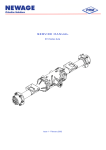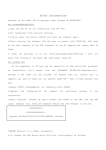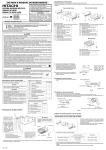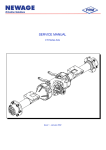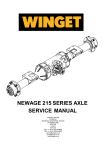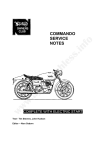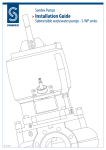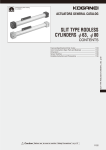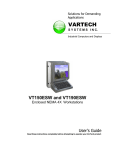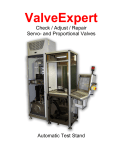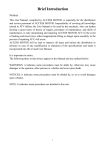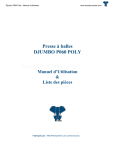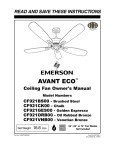Download User Manual
Transcript
SERVICE MANUAL 915 Series Axle 915 Service Manual Issue 1 – September 2003 CONTENT: 1 INTRODUCTION Page – 3 - 2 GENERAL DESCRIPTION Page – 3 - 3 IDENTIFICATION Page – 3 - 4 GENERAL SERVICE INFORMATION .1 4.1 Routine Maintenance .2 4.2 Lubricants .3 4.3 Greases .4 4.4 Brake Fluid – IMPORTANT .5 4.5 Liquid Sealant .6 4.6 Fasteners – Tightening Torque 4.7 Axle Backlash Figures 5 Page – 5 Page – 5 Page – 5 Page – 5 Page – 5 Page – 5 Page – 5 Page – 6 - 915 AXLE ASSEMBLIES Page – 7 - .7 5.1 Section ‘A’ - Crown Wheel and Pinion Assembly .8 5.2 Section ‘B’ - Differential Assembly .9 5.3 Section ‘C’ - Planet Carrier Assembly Page – 10 Page – 12 Page – 14 - .10 5.4 Section ‘D’ - Hub Assembly Page – 16 - .11 5.5 Section ‘E’ - Axle Main case Assembly Page – 18 - .12 5.6 Section ‘F’ - General Parts 6 Page – 7 - SPIRAL BEVEL GEAR TOOTH CONTACT Page – 20 - Page - 2 - 915 Service Manual 1 INTRODUCTION Spare parts for Newage axles may only be obtained from the original equipment manufacturer and not directly from Newage. Always quote your vehicle/machine serial number and axle serial number – see section titled 'Identification.' If possible, the repair/service should be carried out in a clean environment. Where this is not possible and the work must be completed on site, appropriate measures must be taken to ensure that dirt or foreign matter does not enter the unit. Newage axles are designed to operate in the arduous conditions found in the construction industry; providing they are maintained regularly they will provide the service our customers expect from Newage products. 2 GENERAL DESCRIPTION The 915 series axle is a double reduction unit, with oil immersed, multi-plate disc brakes. The centre casing houses the 1st reduction spiral bevel pinion and crown wheel (fixed to a 4 pinion differential), the oil immersed brakes and the 2nd reduction planetary assembly. The axle shafts are fully floating (i.e. not subjected to wheel loads) with the wheel hubs supported on opposed tapered roller bearings. 3 IDENTIFICATION If spares are required, please quote the axle series and the vehicle/machine model and serial number. Newage axles are produced with a variety of track widths, mounting centres, wheel hub centres, ratios and input couplings to suit individual customer requirements, therefore it is important to identify the axle correctly The part number allocated to each axle describes the basic specification as below. Page - 3 - 915 Service Manual 4 GENERAL SERVICE INFORMATION 4.1 Routine Maintenance Ÿ Ÿ Ÿ Ÿ Ÿ Ÿ Check for oil leaks around joints and seals: Check wheel nut tightness: Check wheel hub bearing adjustment: Check axle Arm/Main case joint securing bolts: Check Half Shaft bolts: Check Prop-Shaft Nuts: Weekly Weekly 1,000 hours Monthly Monthly Monthly 4.2 Lubricants Only those lubricants shown below, or their direct equivalents must be used. Ÿ BP SUPER TRANSMISSION S The oil is added via the combined filler/level plug positioned in the rear of the axle main case (Approximate oil capacity of 15 litres (26.4 pints)). • P80 OIL SEAL LUBRICANT – used when installing new oil seals 4.3 Greases Pack the gaps between oil seal lips at major overhauls, or whenever a repair to these areas is performed. Ÿ CASTROL SPHEEROL L-EP2 4.4 Brake Fluid – IMPORTANT The axle brakes operate with a mineral hydraulic fluid (ISO VG32). On no account must a "vegetable" based brake fluid (SAE J1703) be used. Whenever the brakes are serviced it is essential that the cylinder bores, pistons and seals are clean before assembly, and may be lightly coated with one of the mineral based fluids shown below. Ÿ MOBIL DTE24 4.5 Liquid Sealant The ‘Axle Arm/Main case’ joint faces must be sealed with any of the following: Ÿ Ÿ LOCTITE "595" HERMETITE “RED” 4.6 Fasteners – Tightening Torque Ÿ Ÿ Ÿ Ÿ Ÿ Ÿ Ÿ Ÿ spacer Ÿ Ÿ Ÿ Differential assy. bolt (M12) Grade 10 Differential assy. nut (M12) Grade 10 Diff. bearing carrier shoulder bolt (M10) Handbrake end cover cap bolts (M6) Grade10 Diff. Bearing carrier tab washer bolts (M6) Grade 8 Differential bearing adjuster nuts Axle arm-main case bolts (M16) Coupling nut (M20) Drag Torque Wheel nuts. 7/8" B.S.F. Wheel nuts. 18mm Axle shaft/Wheel hub bolts (M16) 115 Nm 115 Nm 61 Nm 14 Nm 10 Nm 21 Nm 206 Nm 2.26/2.94Nm 450 Nm 450 Nm 206 Nm Page - 4 - (84 lb.ft) (84 lb.ft) (45 lb.ft) (10 lb.ft) (8 lb.ft) (15 lb.ft) (152 lb.ft) (20/26lb.in) after collapsing (331 lb.ft) (331 lb.ft) (152 lb.ft) 915 Service Manual 4.7 Axle Backlash Figures Axles Pin/wheel Drive Flange P.C.D. Backlash 915-2180 (1480 Yoke) 108.05 0.47-0.55 Series (915) Assy 915-9520 915-2070 915-2080 Page - 5 - 915 Service Manual 5 915 AXLE ASSEMBLIES. 5.1 Section ‘A’ - Crown wheel and Pinion Assembly Item A1 A2 A3 A4 A5 A6 A7 A8 A9 A10 A11 A12 Qty 1 1 1 As required As required As required 2 1 1 1 1 1 1 1 Description Spiral bevel wheel Input drive flange Spiral bevel pinion Shim 0.05mm Shim 0.075mm Shim 0..25mm Seal Collapsible spacer Bearing cup Bearing cone Plain washer Nut M20 Seal cover Bearing Page - 6 - 915 Service Manual Removing & Servicing the Crown Wheel and Pinion. 1. Remove the drain plug (E6) and drain the axle oil. 2. Remove both axle arm assembly’s by removing 12 bolts per side (F4, page 17). Withdraw the planet carrier assy (see Section C), and sun gear (F7). 3. Remove annulus (F6) using extractor tool or pinch bars. 4. Remove the brake spacer plate (F8) and the other brake components (F9 & F10). See Section F. Use pinch bars at the back of the brake piston (E11) to extract. 5. Unscrew and remove 4 shoulder screws (E9) and extract the Diff. Bearing Carrier (E3) through the bore of the Main case (E1). Feed Diff and crown wheel assembly through bore of the Main case. IMPORTANT: It is essential that a protective sleeve is used over the parts being withdrawn through the bore to prevent damage to the brake cylinder bore. Failure to observe this procedure will result in a loss of brake efficiency or complete brake failure. 6. To remove tab washers (E4) securing the diff housing, release the two screws 2 screws (E23) from Diff adjusting nut (E2) 7. Unscrew brg. adjuster nuts (E2) and push brg. cups (E8) out of bores. 8. While reacting against drive flange to prevent it from turning release the nut (A10) and remove the washer (A9) from the pinion shaft (A3). Remove the flange (A2). Using a soft drift, remove the pinion from inside the main case, taking care not to damage the teeth. 9. Inspect the bearings (A7/A8) for wear and damage. If replacing the inner bearing on the pinion head, use a bearing puller to extract the cone. Discard collapsible Spacer (A6). Drift out brg; Cups (A7/8) from the main case bore, taking care not to loose the shims (A4) located behind the brg; cup of the pinion head bore. IMPORTANT: Once dismantled it is necessary to reset the pinion backlash to ensure the correct meshing of the crown wheel / pinion. Always use new collapsible spacer (A6) and a new nut (A10). See section “F” for the crown wheel / pinion setting up procedure. 10. Record the following information of the original components, in the following sequence. (a) = The pinion (A3) mounting distance etched on the head (range generally between 115.1>114.9mm). (b) = The overall bearing seated width of pinion head bearing, (A12)(generally 30.162mm +/- 0.203mm). (c) = The shim thickness (A4). (d) = (a) + (b) + (c). 11. If replacing the pinion (A3) or pinion head bearings (A7, A8) the following procedure needs to be carried out. Record the following information of the new components to be fitted as follows: (e) = The pinion (A3) mounting distance etched on the head(range generally between 115.1>114.9mm). (f) = The overall bearing seated width of pinion head bearing, (A12)(generally 30.162mm +/- 0.203mm). (g) = (e) + (f) (h) = The new shim thickness (A4) to be determined. 12. New shimming: New Shim thickness = (h) = (d) - (g) Page - 7 - 915 Service Manual 13. To assemble the unit, reverse the above procedure, and proceed as follows. 14. Pinion assy. must be fitted before crown wheel/diff assy. Tighten the new pinion nut (A10) until the new spacer (A6) collapses and the entire end float between the pinion bearings is taken up. Drag torque 2.26 / 2.94Nm (20/26 lb.in). Spin over several times and recheck torque. Note, the tightening torque to collapse the spacer should not be less than 245 Nm (180 lb.ft). This equates to a pre-load of 59-98N (13.2-22lbf) for new bearings, or 29.5-59N (6.6-13.2lbf) for used bearings is obtained. The pre-load is measured by binding a piece of string around the coupling (A2) and measuring the load to turn the coupling with a spring balance – see drawing below. This must be carried out with the crown wheel/pinion mesh disengaged. 15. Fit diff bearing cups (E8) into the main case (E1) and diff brg; carrier (E3). Screw brg; adjuster nut (E2) loosely to retain Brg; cups in housing bores. 16. It is advisable to stand main case on its end with the brg. cup (E8) on the bottom. Lower differential assembly complete with crown wheel through main bore until the bottom bearing (E8) seats in the bearing cup (E8). See paragraph 5 on page 7. 17. Fit Diff. Bearing Carrier (E3) so that the 2 tapped holes for locating screws are towards the brake feed holes on the main case. This is important, as it will allow good oil circulation to other internal components. Ensure that the shoulder screw holes align with the holes in the main case. Apply silicone sealant to under the head prior to fitment of the shoulder screw (E9) and repeat three times. Torque to the recommended figure. 18. Insert bearing cup through Diff. Bearing Carrier (E3) and loosely fit bearing adjuster nut (E2). 19. Position Main case (E1) so bore is horizontal. 20. Adjust both bearing nuts (E2) to obtain the required pinion & wheel backlash. Tighten to the recommended tightening torque. See section 4-7. 21. Locate two new tab washers (E4) to both adjusting nuts (E2) fit two screws (E23) and tighten to the recommended torque. 22. Ensure all joints are clean and free of the original jointing compound and reseal. Locate each axle arm assembly on the dowels positioned in the main case, refit the 12 bolts (F4) and tighten to recommended tightening torque. 23. Refit drain plug (E6) and refill to the correct level with recommended oil. Page - 8 - 915 Service Manual Checking Drag Torque Page - 9 - 915 Service Manual 1.1 Section ‘B’ - Differential Assembly Item Qty Description B1 1 1 2 4 2 4 2 8 8 Diff case LH Diff case RH Diff wheel Diff pinion Thrust washer Thrust washer Diff spider (half) Bolt M12 Nyloc nut M12 B2 B3 B4 B5 B6 B7 B8 Page - 10 - 915 Service Manual Servicing the Differential Assembly Note: This procedure assumes the axle is stripped down to main case assembly only. 1. To remove the annulus (F6) using an extractor tool or pinch bars located behind the annulus in a scissor fashion. 2. Remove the brake spacer plate (F8) and the brake components (F9, F10). See Section E. Using pinch bars at the back of the brake piston (E11) to extract. 3. Remove the 4 shoulder screws (E9) and extract the Diff. Bearing Carrier (E3) through the bore of the Main case (E1). Feed Diff and crown wheel assembly through bore of the Main case. Note: See paragraph 5 page 7. 4. Remove 2 screws (E23) securing the diff brg; housing, tab washer (E4) to the diff brg; adjuster nut (E2). 5. Unscrew brg. adjuster nuts (E2) and push brg; cups (E8) out of bores. 6. Remove the 8 nuts & bolts (B7, B8). The crown wheel (A5) can now be drifted off diff case. assembly will split into 2 halves. Taking care not to lose internal components. 7. The Inspect all gears, bearings and spider for damage and wear. Replace if necessary. 8. To reassemble reverse the procedure. Important: Great care must be taken when refitting the reassembled diff back into the main. Clearance is very limited and to avoid personal injury it is advisable lower the fully assembled diff into the case using a sling made from strong twine. Note: To reset the backlash see page 7 taking note of paragraph 5 also. Page - 11 - 915 Service Manual 5.3 Section ‘C’ - Planet Carrier Assembly Note: This procedure assumes the axle is stripped down to the main assembly only, with planetary Remaining in place. 1. The planet carrier assembly can now be removed from the centre casing. Take care not to withdraw the floating sun gear. 2. Check the planet gears and the mating gear teeth on the annulus and sun gear for damage and wear. The planet gears should run free in the planet pins, without excessive radial “play” Replace if worn. Note: When servicing the planet assembly we recommend all three gears and bearings are replaced. See section A. 3. To replace the planet gears, pins or bearings, drift through the spring dowels (C8), which locates the planet pins (C2) through the planet carrier (C1), lightly drift the planet pins through the planet carrier. Remove the loose planet gears (C4); thrust washer (C5) and planet brgs; (C3). Remove circlip (C6), which secures the spacer (C7). Note: the spacer (C7) is fitted with the chamfer facing outwards. 4. Remove the old spring dowels (C8) from the planet carrier (C1). 5. To reassemble: Replace the spacer & circlip (C6, C7) fit the planet brgs; (C3) into planet gears. (C4) locate the bottom thrust washer, place the planet gear on top of the thrust washer and from the underside gently tap the planet pin through the carrier, thrust washer & planet gear. Note: when you begin this procedure it is important that the cross in the planet pin is aligned with the cross hole in the planet carrier. When part way through fit the top thrust washer and continue to drift the planet pin all the way through the carrier until it is flush. 6. Secure by fitting new spring dowel (C8) and peen over the hole in the planet carrier to prevent the spring dowel from drifting out of position. 7. Check for free rotation of the planet gears. 8. To refit to the main case, engage the spline of the sun gear (F). Mesh the planet gears with the annulus (F6) and push into position. Page - 12 - 915 Service Manual Item Qty Description C1 1 Planet carrier C2 C3 C4 C5 C6 C7 C8 3 6 3 6 1 1 3 Planet pin Needle bearing Planet gear Thrust washer Circlip Spacer Spring dowel Page - 13 - 915 Service Manual Page - 14 - 915 Service Manual 5.4 Section 'D' - Hub Assembly Item Qty Description D1 D2 D3 D4 D5 D6 D7 D8 D9 D10 D11 1 8 8 10 2 1 1 1 1 1 1 Hub (i.e. per side) Wheel stud Wheel nut Bolt M16 x 45mm Dowel pin Bearing Bearing Hub seal Spacer Lock washer Locknut Page - 15 - 915 Service Manual Servicing the Hub Assembly The hub assembly can be serviced with the axle arm still connected to the main case. Procedure is as follows: 1. Remove bolts (D4) that secures the axle shaft (F1) to the hub. By drifting the axle shaft off the dowels and withdraw the shaft. Inspect the spline form for damage and wear. (Flat on hub is provided to aid extraction). 2. Straighten locking tab ears on lock washer (D10), undo lock nut (D11) remove lock washer (D10) and bearing spacer (D9). 3. The hub (D1) can now be withdrawn from the axle arm stub. Care must be taken not to drop the loose brg. cone. 4. Examine all brg; cups & cones for wear or damage replace as necessary. Note: We recommend the hub oil seals are always changed when the hub has been removed. 5. The bearing cup (D6 & D7) can be drifted out of the hub (D1) if they need replacing. When fitting new cups (D6 & D7) ensure that they are aligned squarely to the bores before pressing in. Note: If the brg. (D7) is replaced oil seal (D8) will also need replacing. Note: When refitting D8 oil seal, the bore must be cleaned/ degreased and seal lubricant P80 used. 6. If the oil seal shield (F2) needs replacing it can be drifted off the axle arm. When drifting on the replacement, care must be taken not to damage the oil seal running diameter. Before refitting the seal housing ensure all of the original sealant is removed, this may require use of a solvent. Apply "Loctite" grade 601 to both the to seal housing location point of the arm, and to the seal bore diameter immediately prior to reassembly. Ensure the seal diameter is free from dirt and damage. 7. Prior to reassembly of the hub brgs; apply a recommended quality grease to ensure the brgs; are lubricated on the initial start up. 8. Note: To adjust the hub bearings. Ÿ Tighten the lock nut (D11) to a torque of 140 Nm (100 lb.ft). When checking the torque setting turn the wheel hub a few turns in each direction to ensure the bearings have "seated" correctly and recheck tightening torque. Repeat this procedure 3 times. Ÿ Slacken the nut back a distance equal to 2 tabs of the lock washer (D10). Ÿ Bend ear of lock washer over to secure the nut. 9. To reassemble the hub assembly, clean off the original silicone sealant with a solvent. Reapply a continuous bead of silicone sealant, and reseal the axle shaft joint to the hub using the same silicone sealant, reverse the above procedure using a new lock wsher (D10).Note: To adjust the hub bearings. Page - 16 - 915 Service Manual 5.5 Section 'E' - Axle Main case Assembly (See Diagram on page 17) Item Qty E1 E2 E3 E4 E5 E6 E8 1 2 1 2 1 2 2 2 4 1 1 1 1 2 1 1 1 1 2 2 12 2 4 E9 E10 E11 E12 E13 E14 E15 E16 E17 E18 E19 E20 E21 E22 E23 Description Main case Bearing Adjustment Nut Diff. bearing carrier Lock plate Breather Drain plug / level plug Bearing cup Bearing cone Shoulder screw O-ring small Brake piston O-ring large Bleed valve. Hand brake operation lever Brake level return spring RH Brake level return spring LH Handbrake lever cover RH Handbrake lever cover LH Handbrake lever ‘O’ ring Handbrake lever ‘O’ ring Screw M6 Brake lever bush Screw M6 IMPORTANT: The axle brakes operate with a mineral hydraulic fluid ISO VG32 Specification. DO NOT USE "Vegetable" based brake fluid (SAE J1703) should not be used. 1. To gain access to the brakes, the procedure is the same as previously described in section B 2. When removing the brake plates count them as the number can vary with axle models. Under normal operating conditions the brakes should last several years. The condition of the brakes can be checked as follows: Ÿ Paper brake disc (F9) – not less than 4mm thickness. Ÿ Fixed brake plate (F10) – not less than 2mm thickness. Check for uneven surface wear or heat discolouration on fixed plate. 3. The brake piston (E11) can be gently removed from the cylinder using pinch bars in a scissor fashion locating them behind the piston. Check “o” rings (E10/E12) for wear or damage. Note: All brake components must be free of damage & remain clean at all times, if in doubt change the appropriate parts. 4. To reassemble, reverse the above procedure. Ensure that piston bores are clean and the brake plates are assembled on the sun gear spline (F7) with the oil feed holes in the sintered plates correctly aligned for oil circulation. 5. To remove hand brake operating lever (E14) loosen nut (F14) and bolt (F13) and gently drift the lever from spline. 6. Remove 6 M6 cap head bolts (E21) per side and withdraw cover (E17/ E18), spring (E15/E16) and brake lever LH or RH (F12). Page - 17 - 915 Service Manual 7. Repeat steps 6 and 7 for the opposite hand. Note. The cap, spring and brake lever are ‘handed', and on rebuild must be fitted to the same side of the axle. 8. Check the condition of the brake lever bush (E22) bore. If this requires replacing drift it through the main case. Ensure the replacement is fitted square. 9. To reassemble, reverse the above procedure replacing the brake lever bush “o” rings (E19, E20) with the brake lever bush (E20). Page - 18 - 915 Service Manual 5.6 Section 'F' - General parts Item F1 F2 F3 F4 F5 F6 F7 F8 F9 F10 F11 F12 F13 F14 Qty 2 2 2 24 6 2 2 2 4 4 1 1 2 2 Description Axle shaft Cover wheel hub seal Axle arm Bolt M12 Dowel pin. Annulus Sun gear Brake spacer plate Brake disc Brake plate Brake lever RH Brake lever LH Bolt M10 Nyloc Nut M10 Page - 19 - 915 Service Manual SAFETY: Prior to removal of an axle arm we recommend that lifting tackle is available, due to the weight of the associated components. 1 Making sure the weight is fully supported, remove the bolts (F4) around the flange of the axle arm connecting it to the main case and withdraw the axle arm (F3). Note this can be done with or without the hub assembly fitted to the arm. 2. Before refitting the axle arm, ensure the mating faces on the axle arm flange and centre case are clean and free of damage. Apply a continuous bead of the recommended sealing agent (see section 4.5). 3. Locate axle arms on main case dowels with mounting pad on arm upper- most. 4. Apply approved tightening torque (section 4.6 page 4) to the axle arm bolts diametrically opposed and draw arms onto main case dowels & joint face. 5. Refill with recommended oil to the correct level. Page - 20 - 915 Service Manual 1 SPIRAL BEVEL GEAR TOOTH CONTACT Contact may vary, but approximately in the spaced between root may be towards toe on flanks, or marking towards toe on convex concave flank or vice generally is tooth centre, equiand tip. The marking some gears on both crossed slightly i.e. flank and heel on versa. If, compared to the factory contact, the contact appears as shown below, then corrective action should be taken as follows: 1.1 ERROR 1: Pinion too far out of mesh Convex flank Contact further to toe and tip than factory marking. Concave flank Page - 21 - tooth 915 Service Manual Contact further to heel and tip than factory marking. ACTION: Recheck and decrease shims below pinion cartridge flange. Page - 22 - 915 Service Manual 1.2 ERROR 2: Pinion too far into mesh Convex flank Contact further to heel and root rather than factory marking. Concave Flank Contact further to toe and root than factory marking. ACTION: Recheck and increase shims below pinion cartridge flange. Page - 23 - 915 Service Manual This page is intentionally left blank. Page - 24 -
























